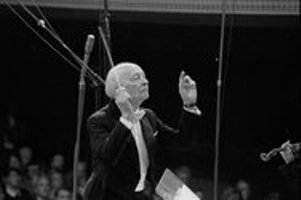Lutoslawski (1)
Lutoslawski Conducts Lutoslawski

Preludia i Fuga (Preludes and Fugue) Orkiestra Filharmoni Narodowej w Warszawie (Warsaw Philharmonic Orchestra) Witold Lutoslawski – dyrygent (condutor) XVII Miedzynarodowy Festiwal Muzyki Współczesnej Warszawska Jesień 1973 (XVII International Festival of Contemporary Music Warsaw Autumn 1973)
Preludes (7) and Fugue was written in the early 1970s, when Lutoslawski's interest in aleatoric procedures was at its maximum. "Aleatoric music" means "chance music," but this wide definition embraces a large number of techniques. In Lutoslawski's case, he usually prescribes the notes but leaves precise time of playing and durations up to the players in certain sections of his music.
The Preludes and Fugue is Lutoslawski's longest composition. Perhaps out of practicality, he allows the conductor to chose any lesser number of the seven preludes in any order, and also provides points at which the fugue can be cut. To make omitting and re-ordering the preludes possible, he begins and ends all of them with the same six instruments playing the same ending hexachord (D#,D,B, B flat, A, G#) or the same beginning hexachord (G, F#, F, E, C#, C).
Pair of intervals of seconds and fifths predominate in the piece. The opening preludes presents a fanfare-like figure which becomes a major structural element of the fugue and its introduction. The second and third preludes both contrast layers of pizzicato versus bowed sounds.
The fourth prelude begins on a unison note F which then fans outward to become a chord, notes being added successively until a twelve-note chord is reached. While this process slowly and quietly proceeds, short repeated notes played ever more frenetically threaten to disrupt it. The fifth and sixth preludes concern themselves with the horizontal line, the one for solo double bass and the other a duet for two cellos. No 7 moves toward a climax but it is deliberately broken off.
An introduction links the fugue with any of the preludes that might precede it. The fugue subject is itself already polyphonic, comprising three individual parts, so that at times there are twelve voices going at once. The fugue is lengthy, with six fugue subjects, all based on a twelve-note row. Each subject has a different character (i.e., cantabile, grazioso, lamentoso, misterioso, estatico, and furioso). This all builds towards an inexorable climax. The climax itself is aleatoric, so that it might be reached at different times by each individual voice. The work was commissioned by Mario di Bonaventura and was first performed at the Styrian Autumn Festival in Graz, Austria, on October 12, 1972. --- Joseph Stevenson, Rovi
download: uploaded filecloudio anonfiles yandex 4shared solidfiles mega nornar
Zmieniony (Środa, 05 Luty 2014 13:03)








